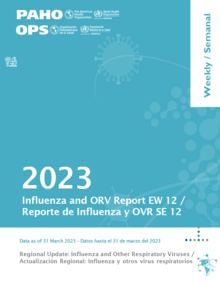North America: Influenza virus activity decreased throughout the sub-region, with the predominance of influenza B viruses. All seasonal influenza subtypes were detected. SARS-CoV-2 circulates at moderate levels, while RSV activity was generally low. Influenza activity was low in Canada and the United States. In Mexico, influenza activity has recently increased at a low-intensity level, with elevated SARS-CoV-2 and RSV activity.
Caribbean: Influenza percent positivity was moderate, driven mainly by influenza B/Victoria lineage viruses. In addition, the influenza A(H1N1)pdm09 virus co-circulated. In Belize, influenza activity was increased, with influenza B/Victoria lineage and influenza A(H1N1)pdm09 co-circulation. Overall, SARS-CoV-2 and RSV activity were low in the subregion.
Central America: Influenza activity was moderate, with influenza B/Victoria virus predominance and co-circulation of influenza A(H3N2) and A(H1N1)pdm09. In El Salvador, influenza activity was elevated due to influenza B/Victoria and A(H3N2) viruses, and Guatemala reported increased activity with all seasonal subtypes detected. In Honduras, influenza activity was increased due to influenza B viruses. SARS-CoV-2 percent positivity dropped in the subregion, except in Costa Rica. RSV activity was low overall.
Andean: Influenza activity was low, predominating influenza A(H1N1)pdm09 viruses; influenza B/Victoria and A(H3N2) viruses co-circulated. Bolivia reported increased influenza activity, with SARI cases / 100 hospitalizations at moderate levels and 14% positive for influenza. In the subregion, SARS-CoV-2 and RSV activity were low overall.
Brazil and Southern Cone: Influenza activity was low, with influenza B viruses more frequently detected and all seasonal influenza subtypes detected. Increased SARS-CoV-2 activity was reported in Brazil, Chile, and Paraguay, while RSV was elevated in Brazil.
Global: Influenza activity decreased following a peak in late 2022 but increased again in late February to March with an increase in influenza B virus activity. During this reporting period, influenza A viruses predominated, with a larger proportion of A(H1N1)pdm09 viruses detected among the subtyped influenza A viruses. In Europe, overall influenza detections decreased, and influenza positivity from sentinel sites was stable and remained above the epidemic threshold at the regional level. Out of 37 countries, 16 reported medium intensity, with the remainder reporting low or below baseline intensity. Eighteen of 36 countries reported widespread activity. Overall, influenza B viruses predominated in both sentinel and non-sentinel surveillance, as all subregions experienced a wave of influenza B activity after an initial influenza A wave. In Central Asia, influenza activity decreased. In Northern Africa, influenza detections were very low across reporting countries. In Western Asia, influenza activity continued to be reported in some countries with detections of all seasonal influenza subtypes. In East Asia, influenza activity of predominantly A(H1N1)pdm09 steeply increased in China but decreased in the other reporting countries. In tropical Africa, influenza activity increased in some countries of Western Africa, while detections were low across reporting countries in Middle and Eastern Africa. In Southern Asia, influenza activity remained low, with influenza A(H3N2) and B/Victoria lineage viruses predominant. In South-East Asia, influenza activity remained elevated, with influenza B mainly detected in Malaysia and A(H3N2) in Singapore and Thailand. In the temperate zones of the southern hemisphere, influenza activity remained low.
SARS-CoV-2 positivity from sentinel surveillance remained around 20% globally. Activity remained at about 25% in the WHO Region of the Americas and around 15% in the Eastern Mediterranean region. Activity remained around 10% in the other regions. SARS-CoV-2 positivity from non-sentinel surveillance was reported at approximately 30% globally.
Avian Influenza: A summary of the avian influenza situation in the region, case management and recommendations are available at Epidemiological alerts and updates | PAHO/WHO | Pan American Health Organization (paho.org)
|

